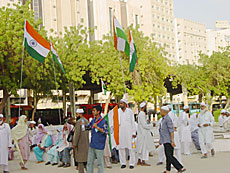JEDDAH, 3 January 2006 — Aziziah is proving to be a good thing for many Indian pilgrims this year. Despite an odd problem or two, Aziziah is one of Makkah’s best-planned areas, featuring very comfortable accommodation and a road network leading straight to the Holy Mosque through a tunnel reserved only for pilgrims.
Aziziah is being promoted by Saudi authorities as a Haj township. Though it is a considerable distance from the Holy Mosque, because of the construction and consequent congestion in the holy city, it is nonetheless a viable housing alternative. The mammoth Jabal Umar project has forced a number of countries from South and Southeast Asia to look for reasonable accommodation for their pilgrims in areas such as Aziziah.
For many pilgrims and their relatives in India, however, Aziziah means inconvenience. They say it is too far away from the Holy Mosque. The Haj committee officials as also politicians in India base their opinions on the distance from the Holy Mosque completely forgetting not only Makkah’s geography but also the amount of construction in progress there.
An independent visit to Aziziah by Arab News last week was full of revelations. Not only are the buildings comfortable but the facilities are also first class. Buses are available to ferry pilgrims to and from the Holy Mosque. The Hafil and SAPTCO transportation is free, and Indian mission volunteers are visible everywhere holding the Indian tricolor guiding pilgrims to the right buses.
Aziziah has been, and is still, patronized by the Emiratis, Indonesians and Bahrainis. They have deliberately opted for Aziziah in order to avoid problems associated with buildings closer to the Holy Mosque.
Indian Consul General Dr. Ausaf Sayeed admitted that there were a number of misgivings in the minds of people about Aziziah. “However,” he said, “they need to be educated that though it is far off, the kind of amenities that are available there are not available anywhere else.
“There is the reserved tunnel which only SAPTCO and Hafil buses can use so there is no question of traffic jams in the tunnel. It takes pilgrims straight to the Holy Mosque from the Safa-Marwa side in less than 15 minutes,” the consul-general added.
The residential accommodation closest to the Holy Mosque for Indian pilgrims is called Ashraf which includes Buildings No. 1, 2, 3 and 4. A multistory complex, it is exactly opposite Ajyad Hospital and from its front door to the Holy Mosque is a seven-minute walk. The problem, however, is with the limited number of lifts in the complex.
“I had to wait for nearly 20 minutes to get into the lift,” said an Indian pilgrim staying in the building. He said he was happy to be so close to the Holy Mosque but, as he explained, everyone rushes out at the same time for prayers. As a result, there is a long queue for the lifts so it may take 20 minutes for a pilgrim to get to the Holy Mosque from his or her room.
On the other hand, from Aziziah it takes less time to reach the Holy Mosque because of excellent transportation facilities and the reserved tunnel. In addition in Aziziah, included in the total price that pilgrims pay are breakfasts provided by the buildings’ owners.
When Arab News visited a building in Aziziah, a group of Kashmiris who were staying close to the Holy Mosque had come there to inquire about moving into one of the Aziziah buildings.
“We thought of getting into one of these buildings because the amenities here are so much better than the ones in the buildings close to the Holy Mosque,” said one of the group’s members. “These are new buildings. We were initially discouraged because of the distance but if there is free transportation, what else do you need?”
The other group members nodded in affirmation.
“I had similar misgivings,” said Azhar Ali, a Jeddah resident whose relatives have come for Haj. He got his relatives into Aziziah though they were originally in the Jarwal area, which is considered close to the Holy Mosque.
“That is the hilly area, and my relatives had to walk quite a distance to reach the Haram,” he said. “Aziziah is much better in the sense that now they don’t have to walk through crowds and climb an incline in order to reach the Holy Mosque.”
The Indian Haj mission’s decision to move into Aziziah was taken in light of circumstances; a number of units previously used by the Indian mission were demolished and it is believed that some 200,000 other units in Shamiya will be demolished next year.
“In any case, we would have had to move into Aziziah next year,” said the consul general. “We hired 540 buildings this year,” he said. “We identified about seven buildings with problems.”
He said more than 600 part-time workers and volunteers have been employed to look after the pilgrims. There are nearly 140 doctors staffing the health clinics in Indian mission buildings and there are more than 100 paramedical staff as well.
Dr. Suhel Ejaz Khan, Haj consul and himself a medical doctor, insisted that the mission was providing excellent medical facilities for the pilgrims and this is easily corroborated by independent visits to some of the clinics.
Although consular officials don’t discuss it, the fact remains that an Indian pilgrim is being charged perhaps the least among all South Asian pilgrims — even less than those from Bangladesh. That considered, the arrangements are indeed commendable.


